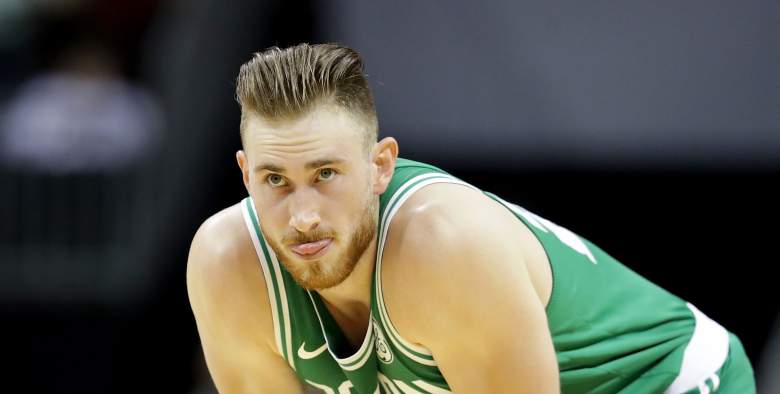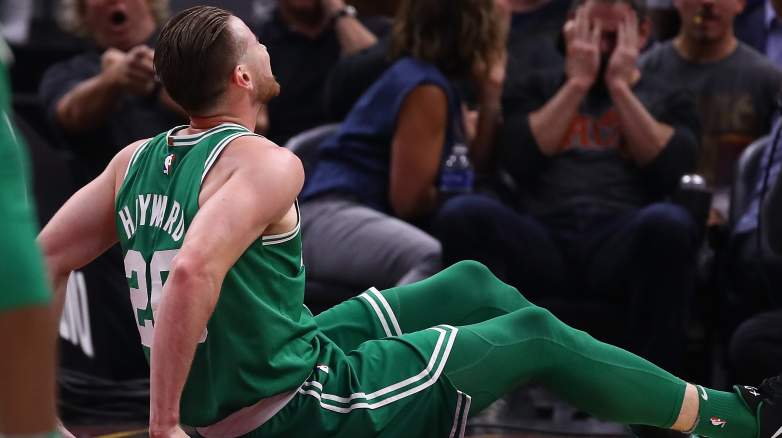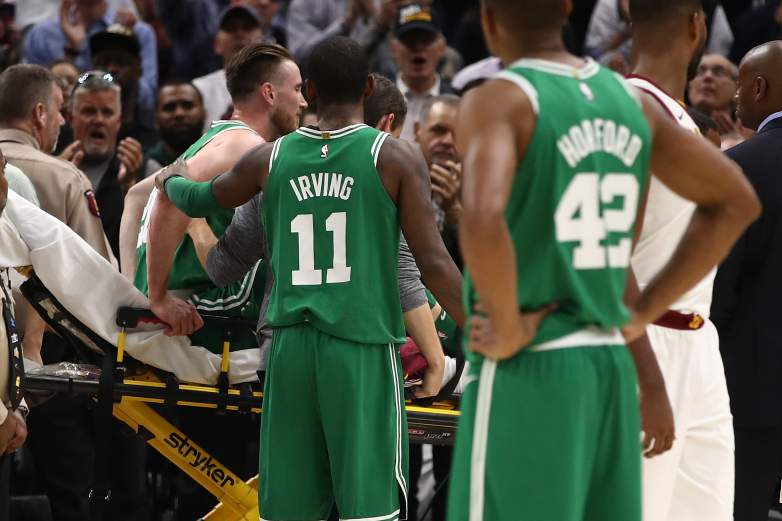
Getty Gordon Hayward of the Boston Celtics.
In a traumatic and shocking on-court development, halfway through the opening quarter of the Celtics-Cavs game, Gordon Hayward suffered a leg injury as the Celtic landed hard while trying to catch a pass.
Hayward collided in the air with LeBron James and Jae Crowder, and immediately appeared badly wounded, with his foot twisted in an unnatural angle. You can watch the video below, but be aware that it’s disturbing. “Gordon Hayward’s foot looked to be at a 90 degree angle from his leg. Have never seen something like that before. Players in shock,” wrote the Washington Post’s NBA writer.
“Hayward has broken his leg,” legendary announcer Kevin Harlan shouted on TNT. It later turned out that Hayward had not broken his leg. Rather, he has a fractured ankle. Specifically, Hayward has a fractured tibia and dislocated ankle, according to MassLive. The tibia is the larger of the two leg bones (with the fibula the other), and it’s sometimes called the shinbone.
What’s the nature of his injury? How many games will he miss? What’s the recovery time?
Here’s what you need to know:
1. Fans Were Stunned to Watch the Injury Occur & Gave Hayward a Standing Ovation
“Hayward has broken his leg, Hayward has broken his leg,” the announcer shouted as the injury occurred. You can see Hayward writhing on the floor and clutching his leg in the disturbing video.
“Hayward’s left ankle turned at such an odd angle that teammates stood in shock as he motioned for help from the sideline,” ESPN reported.
According to the Boston Globe, “As Boston’s medical staff tended to Hayward, the rest of the team gathered in one big group hug on the other side of the court. A compression cast was put on Hayward’s left leg and he was rolled off of the court as he received a standing ovation.”
On October 18, Hayward taped a video message for fans, telling them he will be “all right” and saying, “What’s up, everybody? I just wanted to say thank you to everyone who has kept me in their thoughts and prayers. I’m going to be all right. It’s hurting me that I can’t be there for the home opener; I want nothing more just to be with my teammates and walk out onto that floor tonight. I’ll be supporting you guys from here. I wish you the best of luck. Kill it tonight.”
2. Hayward Fractured His Tibia, the Team Confirmed

GettyGordon Hayward suffered a horrific injury in the NBA’s opening game.
Although at first people thought he had broken his leg, the team quickly confirmed that Hayward had actually suffered an ankle injury. The Boston Globe reported that the injury is to Hayward’s left ankle. Several hours after the game, coach Brad Stevens revealed the specifics: A fractured tibia and dislocated ankle.
Chris Mannix, of The Vertical, tweeted, “Hearing some cautious optimism on Hayward’s injury. Being described as what looks like a clean break. More learned back in Boston.”

Kyrie Irving #11 of the Boston Celtics consoles Gordon Hayward #20 after Hayward was injured.
The injury shook up the team.
“The team later announced that Hayward fractured the ankle,” ESPN reported, adding, “Fans gave Hayward a standing ovation as he was taken from the court with his entire left leg immobilized in an air cast. He was immediately taken to the Cavaliers locker room for more evaluation.”
What’s the physiology of the ankle?
According to SportsMD, “The ankle joint is a hinge joint that consists of parts of three bones: the tibia, the fibula, and the talus. The bottom (distal) end of the fibula forms the lateral malleolus which is the bump on the outside of the ankle. The bottom (distal) end of the tibia (the ‘shin bone’) forms the medial malleolus which is the bump on the inside of the ankle, the posterior malleolus on the back of the ankle, and the plafond, or ‘ceiling’ of the joint.”
Not all fractured ankles are equal in seriousness. The Boston Sports Journal had earlier reported that Hayward’s injury was likely “tibiotalar fracture-dislocation,” which has now been confirmed by the Celtics, in addition to the dislocated ankle.
https://twitter.com/KingNahrora/status/920487822263574528
“An ankle fracture can vary from mild to severe. Occasionally, the ankle joint may be dislocated, or completely out of socket, in association with a broken ankle. This is a more severe injury,” reports SportsMD.
“Sports injuries, such as a fall while skiing or running into another player during soccer, are lower-energy injuries that can cause tibial shaft fractures. These fractures are typically caused by a twisting force and result in an oblique or spiral type of fracture,” according to the American Academy of Orthopaedic Surgeons.
3. Hayward Will Likely Be Out For the Season, as Tibia Fractures Typically Take Several Months to Heal
Obviously, Hayward is receiving medical attention, and it’s hard to know immediately how many games he will miss. The general rule of thumb with this kind of injury is 4-6 months.
A fractured ankle and tibia are serious injuries, and, minimally, he will require several months of recovery. “Some tibial shaft fractures heal within 4 months, yet many may take 6 months or longer to heal. This is particularly true with open fractures and fractures in patients who are less healthy,” reports the American Academy of Orthopaedic Surgeons.
It was quickly clear that the wound would likely cost Hayward the season.
“It is unclear how long Hayward will be out, but given the gruesome nature of his injury, he could be gone for the season,” SB Nation reported.
“That will likely cost Hayward the entirety of the 2017-18 campaign, though the Celtics haven’t provided any sort of update on a potential timetable,” the network reported.
The consensus is that Hayward’s recovery will take several months, at least.
“Dr. Chris Chihlas (Southcoast Health Orthopedic Surgery & Sports Medicine) on @NBCSBoston believes Gordon Hayward will return in 4-5 months,” a local radio host tweeted.
According to SportsMD, some fractured ankles require surgery, but others do not. “Nonoperative treatment may consist of a short leg cast or a brace for 4-6 weeks. Weight bearing may be allowed when it no longer hurts to put weight on it. After 4-6 weeks, range of motion and strengthening exercises are used to re-establish strength and flexibility. Sports can usually be resumed at 3 months if strength, range of motion, and agility are re-established,” the site notes. The Celtics have not yet said whether Hayward will require surgery.
Hayward indeed required surgery, reported ESPN, and he had that surgery on the evening of October 19. His agent told ESPN that the surgery would include “inserting a plate and screws to stabilize Hayward’s ankle and tibia,” and he wasn’t ready to give a recovery timetable until after it.
Jessica Flynn M.D., writing for Boston Sports Journal, had predicted that Hayward would likely require surgery because of the tibia fracture.
“The treatment for an injury like Hayward’s, most likely a tibiotalar fracture-dislocation, is surgery,” she wrote. “The surgeon will reduce the ankle (I know they did it on the court, but it’s likely not stable), use some plates and screws to fix any fractures, scope the joint to address any cartilage injuries, and possibly repair any ligament damage. This surgery is sometimes delayed to allow swelling to go down so that soft tissue/skin healing complications can be avoided.”
She thinks the Celtics should not count at all on Hayward this season, unfortunately.
“We don’t know the extent of the damage to the ankle. Best-case scenario at this point is surgery within a few days, weight-bearing 6 to 8 weeks later, and a possible return to practice in 4-to-6 months. That puts us at March-April. Sadly, while I am definitely holding out hope for positive, surprising news, I do not think we will see much, if any, meaningful basketball from Hayward until next season,” Flynn wrote.
SportsInjury Clinic reports that “the tibia is the big bone in the lower leg. A tibial fracture is the most common injury of all long bone fractures and takes a variety of forms but usually involves a long period of immobility and a long recovery time.” How long depends on the severity of the fracture, which is information not yet clear in the Hayward case.
Even simple fractures of the tibia, though, can result in a patient – NBA player or not – being immobilized for at least 12 weeks, the site reports, while complex fractures can take six months to heal with the patient on crutches during that time.
Stack.com reports that ankle surgery can require an arduous recovery process. “Recovery from ankle surgery can be a real bear. First, you’ve got an average of six weeks in a cast. Once you’re done with that, you still have about six more weeks of avoiding weight-bearing activities like running,” the site reports. After surgery, an athlete may have to work to regain strength and power in the ankle, according to Stack.
Fans immediately grasped the magnitude of the injury, but some held out hope that, because the ankle was fractured, Hayward might not miss the full season.
A review by Sports Health of NBA injuries over a 17-year time frame found that ankle sprains, which are obviously less severe than the injury Hayward suffered, are the most common injury. “Professional athletes in the NBA experience a high rate of game-related injuries. Patellofemoral inflammation is the most significant problem in terms of days lost in competition, whereas ankle sprains are the most common injury,” the study found. “True ligamentous injuries of the knee were surprisingly rare. Importantly, player demographics were not correlated with injury rates.”
4. Odell Beckham Suffered a Similar Injury in Early October but Basketball Has a Higher Proportion of Ankle Injuries
Hayward is the second pro athlete to suffer a fractured ankle this month. A prominent football player suffered a similar injury in early October.
CBS Sports reported in early October that New York Giants’ wide receiver Odell Beckham “got hurt in a bad way…Beckham reinjured the same ankle he hurt in the preseason on a nasty looking play. The Giants confirmed that Beckham suffered a fractured injury and the team said he may require surgery.”
In 2012, the Yankees’ Derek Jeter suffered a fractured ankle injury. Sports Illustrated reported at that time that the type of position a pro athlete plays in can affect recovery time in such instances. “This type of fracture would normally take between six-10 weeks to recover from for a baseball player. It is longer, often as much as 12 weeks, for a middle infielder due to their need for lateral motion and quick, forceful moves on throws and turning double plays at the bag,” the magazine reported.
A 2012 research study in Sports Health found that “The ankle is the most common site of injury in 24 of 70 sports. Ankle sprain accounted for 76.7% of injuries, followed by fractures at 16.3%. Basketball and soccer have a higher proportion of ankle injuries. In soccer, the risk of injury during match play is 4 to 6 times greater than during training.”
Plus, the Green Bay Packers’ QB Aaron Rodgers broke his collarbone, possibly taking him out for the season. Isaiah Thomas, of the Cavs, is also still recovering from a hip injury. You can read more about that here:
5. Hayward Was Supposed to Be a Key Player on the Celtics Team This Season

Gordon Hayward after suffering from the injury.
The injury was even more startling because the Celtics had just signed Hayward, and they were counting on him to deliver big for the team this season.
“The Celtics signed Hayward to a near-max contract after he led the Utah Jazz to their most successful season this decade. He was set to become the premier wing player for a Boston Big 3 that also featured Kyrie Irving and Al Horford,” SBNation reported.
The Boston Globe noted that Hayward’s contract spans four years and is worth $128 million. It was only inked in July.
Look for Jaylen Brown and Terry Rozier to now get more time on the court. “With Hayward sidelined, Jaylen Brown will likely get all the minutes he can handle, while Terry Rozier should be in line for a bigger role as well,” reported CBS Sports.

